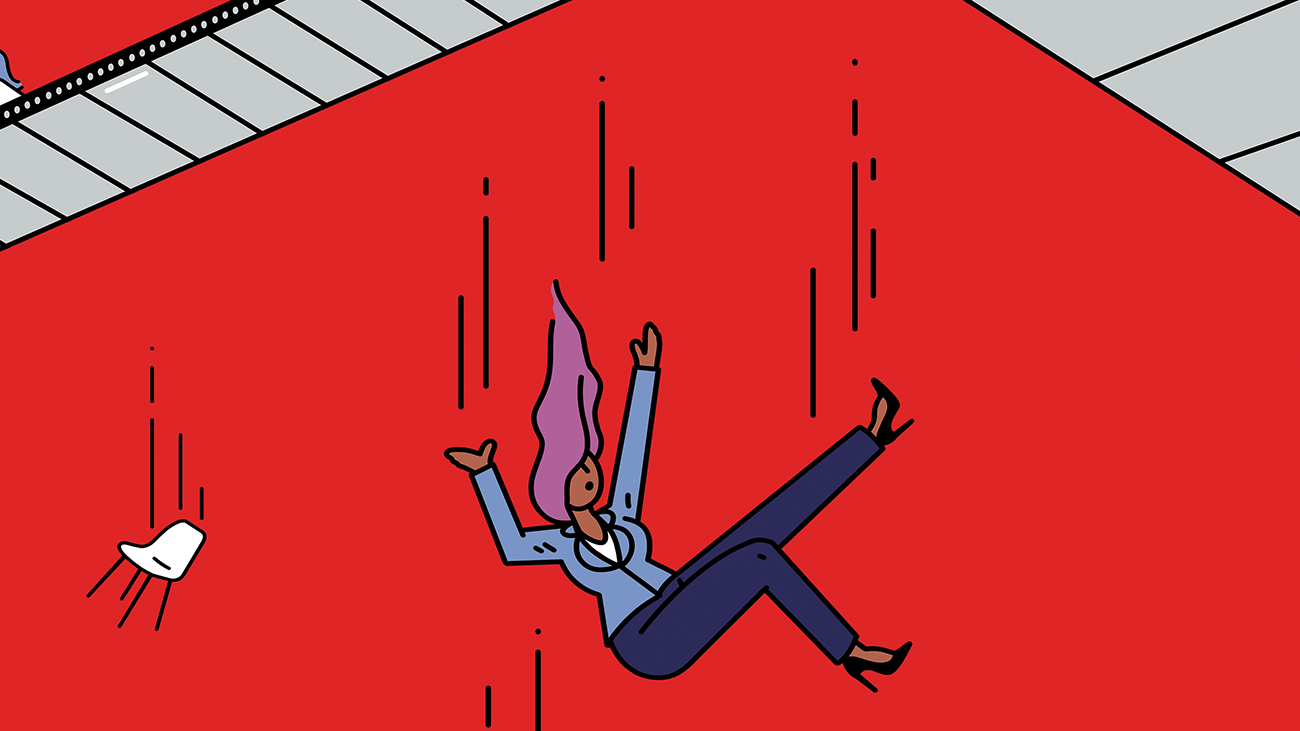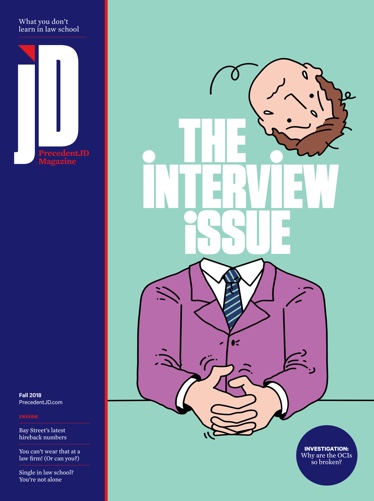
THE DINNER
The dinner began with a round of cocktails. On one side of the table, partners from a Bay Street law firm were skimming the menu. And sitting on the opposite side, anxious law students squirmed in their chairs. They had good reason to be tense. The students, who were two months into their second year of law school, were each competing for the same thing: a job at the firm for the upcoming summer. Most students covet these positions, which pay the highest salaries, come with a guaranteed articling gig and carry social cachet.
By this point, the students had already interviewed with the firm at least twice. And they had performed well enough to earn an invitation to this final stage of the recruitment process: a four-course meal, at an upscale downtown restaurant, with a group of partners.
In one sense, the meal unfolded like a job interview. The partners asked a series of questions and the students did their best to answer. But in most ways, it was nothing like an interview. For one thing, the dinner lasted four hours. And there was plenty of alcohol to go around, which makes it much harder to deliver coherent, thoughtful responses.
One of the students at the table was Jessica George. In her head, she kept a running tally of all the drink orders. “Once we finished our cocktails, the partners ordered wine for the table,” she recalls. “We conquered a few bottles. Then we had aperitifs at the end. That’s a lot of booze.”
When the partners began to ask questions, they had nothing to do with law. The polite chatter turned, at times, to sports and television. But the low point, for George, arrived when one of the partners asked the following question: What is your favourite overseas destination? “I know the partner was not trying to be malicious,” says George. “He was just trying to find an easy way to have a casual conversation, but he assumed that everyone would have been overseas.”

George, who is Ojibway, grew up in northwestern Ontario, near the reserve of the Couchiching First Nation. Her family never had the money for air travel. And so, with one fell swoop, the partner had made her feel like an outsider.
It got worse. The partner decided to break the ice and answer first. “He says something like, ‘Well, I’ve been to Barcelona eight times, so I’d have to pick that,’” recalls George. “Then one of the students says, ‘I’ve been to this European city 10 times, so you might think that’s my favourite destination, but it’s actually Fiji, where I’ve only been once.’”
George felt even more left out. When it was her turn to speak, she replied with candour: “I didn’t travel when I was growing up. We didn’t have the means to do so. And now I’m a law student in Toronto, I spend my time and money to go home and visit my family.”
Her answer was met with silence. “It was crickets,” recalls George. “They all looked at me like I was this thing. Then they moved on to the next question.”
This dinner took place four years ago. George, who was a 2L at Osgoode Hall at the time, did not begin law school with Bay Street ambitions. But when recruitment season began, she identified four large firms with practice groups that serve Indigenous businesses. So she applied to those firms with that specific goal in mind.
To cut to the chase: no, George did not receive a job offer from the firm with the Barcelona-loving partner. But she did land a summer gig at Gowling WLG. And she’s still there today, as a second-year associate, building up her expertise in Indigenous business. “I know I fell into Bay Street,” she says, “but I’m actually very happy.”
The recruitment process on Bay Street begins well before these dinners. It gets under way, like clockwork, the moment first-year students finish writing their last exam. That’s when they pivot from school and start to labour over their applications, which are due in mid-August. This deadline is set by the Law Society of Ontario, which regulates the entire recruitment regime.
On average, the largest firms receive about 1,000 resumés and cover letters. They typically winnow those down to the best 200 or so candidates, who they intend to meet in October for “on-campus interviews” (referred to, colloquially, as OCIs). This is when the recruitment season takes flight. Both law firms and government agencies throughout Toronto dispatch a crack team of recruiters to law schools across the country. Once they arrive, they have one day — or two days, if they’re holding interviews at Osgoode Hall or the University of Toronto — to interview candidates in 20-minute intervals. On campus, students often refer to this process as “speed dating with law firms.”
The cost to employers is substantial. For one thing, they have to cover travel costs and hotel rooms for their recruitment team. They also have to pay a fee to each law school — which ranges from $300 to $1,500 — to cover the costs of hosting them.
But this is just the beginning. Next comes “in-firm” week. During this three-day window in early November, employers interview the best students they met during the OCIs at their offices in Toronto. Interviews start at 8 a.m. on Monday and run to midday on Wednesday. During the evenings, firms host dinners and cocktail parties for applicants. If a student has multiple interviews (and many do), these days can be exhausting, as they sit for interviews all day and juggle networking events in the evening.
The process reaches its climax at 5 p.m. on Wednesday. This is when employers are allowed to make job offers. At the top of the hour, they start calling their favourite candidates. For students who land a job, this moment is euphoric. But for those who watch as their phone sits in silence, the experience is nauseating.
And with that, it’s over. Only at this moment can the rest of the legal employers — those that neither held OCIs nor in-firm interviews — begin their recruitment of summer students.
The Bay Street recruitment process is more than complicated. It is rife with flaws. There are, of course, the dinners, which can alienate job applicants from diverse communities. There is law-school culture, which misleads too many students into believing that their future careers hinge on whether they land a Bay Street job. And there’s the deep anxiety students feel around their first-year grades, which make up the cornerstone of most job applications. But though the entire profession agrees that these problems are real, there is no broad consensus on how to make this process better.
What follows is an in-depth investigation into these systemic problems. And it starts with a simple question: where does this recruitment process come from in the first place?
THE ORIGIN STORY
When large law firms recruit for summer students, their goal is clear: to find the brilliant young minds that will, over time, become the firm’s associates, partners and rainmakers. It’s no small task. And because the stakes are so high, no firm wants to hire after a competitor. This explains why firms meet with students at an agreed-upon time each year.
Before 1999, however, the recruitment of second-year law students took place in the winter term — not in the fall. The process was also much simpler. The deadline for applications was the last week of January. Firms held interviews at their offices during Reading Week. And they could make job offers on Wednesday. The whole thing lasted less than a month.
So why did things change? In the late 1990s, the top firms on Wall Street started to hire an increasing number of Canadian law students. They had also started to conduct on-campus interviews at three law schools: Osgoode Hall, the University of Toronto and McGill University. And they were showing up in the fall. Needless to say, Bay Street was not pleased.
The large firms acted fast. They gave their student complements a raise from about $700 to $1,000 a week — though this number came nowhere close to the US$1,800 students earned in New York. (Bay Street has since upped this number to $1,450, while the top firms on Wall Street pay students more than US$3,000.)
Firms wanted to make a more drastic change, too. They wanted to move the recruitment of second-year students up to the fall. They also wanted to conduct on-campus interviews. In short, they wanted to ape the New York model.
But firms did not have the authority to unilaterally overhaul the recruitment process. So they went to the Law Society of Ontario and asked it to rewrite the rules. In March of 1998, the Law Society did what it does best: it put together a working group to look into the viability of such a proposal.
Over the next three months, the working group sought feedback from law students, law schools and recruiters. It then analyzed the summer-student job market and crunched the numbers.
By the summer of that year, it presented its final report at Convocation, a monthly meeting of the elected benchers who govern the Ontario legal profession. According to the report, approximately 44 law students had, in the previous year, taken summer positions in New York. The report concluded that these students were, indeed, “at or near the top of their class.”
This looked like a textbook brain drain to the south. The report went on to say, “Most large downtown Toronto firms feel strongly that fall recruitment is the only model that will allow them to stem the tide of highly qualified students leaving for the U.S.”
But when the working group heard from students and law-school administrators, they received a different message. This group “wondered whether the problem was large enough to warrant a complete overhaul of the system.”
They pointed out that if job interviews took place in the fall, employers would have to evaluate students on their first-year marks alone. Such a change would be unfair to those who “need time to adjust to law school before excelling academically,” a problem that was “of particular concern for Aboriginal students, students with family responsibilities, and students with English as a second language.”
The benchers had a clear choice: they could side with the students or the largest law firms. In the end, they voted 19 to two — with two abstentions — in favour of shifting recruitment to the fall. With that, the current recruitment process was born.
MAKING THE GRADE
Two decades later, David Rybak sat in a lecture hall at the University of Toronto. He was a first-year law student and the school had just released its first semester grades. Rybak scanned the room. “One person in the class looked like she’d won the lottery,” he recalls. “Another person looked like he’d seen his parents get hit by a semi-truck. And another looked like both of those things had happened simultaneously.” He was sitting next to a classmate he barely knew. “I guess she had to talk to someone because she turned to me and said, ‘David, my recruit plans are ruined.’”
If recruitment season took place in the winter of second year, as it did two decades ago, these grades would not carry so much weight. This would ease the burden first-year students feel during exam time. But Rybak thinks that, to understand why students struggle with less-than-exceptional report cards, one has to look beyond the timing of OCIs.
He should know: for the past five years, he has struggled with anxiety. Rybak grew up near Stoney Plain, a rural town in central Alberta. He was the first person in his family to graduate from university. “In high school, I felt like I was one of the smarter people in the room,” he says. But when he arrived at the University of Alberta, to study philosophy, he started to doubt himself. “If I was reading a philosophical paper and couldn’t grasp the point, I would start panicking and get very frustrated,” he recalls. “I’d remember all of the hard work I’d done and think, After all that, I still can’t do this one thing? What have I done with my life?”
He started to attend group-therapy sessions and see a counsellor. Over time, he developed a coping mechanism: “I try to focus on what I can control, but prepare for the worst, so that if things go well, I’ll be pleasantly surprised.”
When Rybak participated in the second-year recruit, his low expectations were exceeded. In the summer of 2017, after his first year of law school, he landed a plum position at Weil, Gotshal & Manges LLP in New York. He didn’t back out of the Toronto OCIs, though. This is, in fact, pretty common: the New York summer program lasts about 12 weeks, so students who secure a position there often work two to four weeks at a Toronto firm to round out their 16-week summer break.
Rybak met with six firms and landed in-firm interviews at four of them. Which meant that two firms turned him down. Logically, he knew this wasn’t the end of the world. But he immediately thought, Oh my god, you’re such a failure. “Yes, I know, this is absurd,” he says. “I’m the guy with the New York job who didn’t get two in-firm interviews.” Better still, he went on to spend two weeks this past summer at Torys LLP in Toronto.
The moral of his story is that law-school anxiety is a problem that runs deep. “You have a bunch of Type A, anxious students in their 20s who probably haven’t gone through much career or academic adversity,” says Rybak. “And now, all of a sudden, like me, they’re not the smartest person in the room anymore.” It will take more than rescheduling the recruitment process to help students handle this transition.
INSIDE THE BREAK ROOM
“Do you want to know the worst part of the process?” asks George. “It’s the break room.” On the day of their OCIs, students assemble in a large meeting room where they wait for their interview time to come up. Most students spend much of their day in that room.
The anxiety in the air is palpable. “The moment I arrived, it was clear that some students were trying to pump themselves up by tearing others down,” says George. “Right away, people glommed onto me and started to show off the study materials they brought. They said, ‘Look, I brought profiles of all the firms I’m interviewing with.’ Then they showed them to me and they’re all highlighted. And when I told them I had that information in my head, they went, ‘Aren’t you going to forget, though?’ And then I doubt myself and think, Oh no, maybe I am going to forget! That room brings out the worst in law students.”
 Heather Donkers, a third-year law student at Osgoode Hall, also disliked the break room. “That room is not conducive to anyone’s mental health or well-being,” says the president of the Law Students’ Society of Ontario, who landed a job through the OCIs at the Ministry of Community Safety and Correctional Services. “It honestly felt a bit surreal.” When she walked in, the first thing she noticed was the clothing. “Everyone was dressed in black or grey. I wore a black suit, but had a bright blue shirt on underneath. I stuck out like a sore thumb.” At lunchtime, things got more uncomfortable. “Everyone was so anxious about their interviews that they were all just poking at their food. If we got rid of that room, that would be great.”
Heather Donkers, a third-year law student at Osgoode Hall, also disliked the break room. “That room is not conducive to anyone’s mental health or well-being,” says the president of the Law Students’ Society of Ontario, who landed a job through the OCIs at the Ministry of Community Safety and Correctional Services. “It honestly felt a bit surreal.” When she walked in, the first thing she noticed was the clothing. “Everyone was dressed in black or grey. I wore a black suit, but had a bright blue shirt on underneath. I stuck out like a sore thumb.” At lunchtime, things got more uncomfortable. “Everyone was so anxious about their interviews that they were all just poking at their food. If we got rid of that room, that would be great.”
The break room is also a source of gossip. “The week after OCIs, people will say things like, ‘I didn’t see this person in the break room, but I know they applied, so I guess they didn’t get an interview,’” recalls Sachin Seth, another second-year associate at Gowlings and a graduate of Osgoode Hall. “I heard that about so many people. I even heard that about myself. But really, I only had one interview and once it was over, I left.”
Though George is critical of law-firm culture, she also has a message for the current generation of law students: “We have to be better to each other. We shouldn’t be cutting each other down.”
THE PARTIES
Christina Beaudoin, the director of student programs and legal recruitment at Osler, Hoskin & Harcourt LLP, has overseen the firm’s on-campus interviews for the past 10 years. Beaudoin travels with a small team of lawyers to each school, where they interview between 20 and 60 students per day.
This poses a challenge. Beaudoin, like most of the law-firm recruiters who participate in the OCI process, has to rely on lawyers who lack formal human-resources training to properly identify talent. “We don’t want to turn an interview into a casual chat,” she says. “Then it becomes more about ‘fit’ and whether we like the candidate. The last thing I want is for someone to come to me and say, ‘This student played varsity hockey, so they’d be great on our team.’ That is not good enough.”
Osler has devised a solution. “We have a set of standardized questions that we use to elicit whether the student has the key competencies that we value,” she says. To pinpoint students with the ability to collaborate, for instance, interviewers might ask this question: “Tell me about the most difficult team you’ve ever been a part of — how did you deal with that?”
That’s not to say every firm is so strict. “During the most recent recruitment season, I heard that one firm asked a student what they thought of the Donald Trump presidency,” says Jordana Laporte, the director of the career development office at the University of Toronto’s faculty of law. “This put them in a terrible position. They couldn’t quite tell if it was a joke or if they had to offer an honest answer.” (Her suggested response to such a question: “I’m not comfortable talking about this subject.”)
But many students think that, in general, the on-campus interviews are the most professional part of the process. “The best thing about the OCIs is that they’re short,” says George. “So even if they’re not structured, there isn’t time to get too far off track.” The big problems come later. “The in-firm interviews are longer, so they can get pretty informal, and it’s the dinners and cocktail parties that get extra sketchy.”
George is not the only one to have felt like an outsider at a Bay Street social event. In the fall of 2016, Sheri Wang, a then-second year law student at the University of Calgary, flew to Toronto for in-firm week. On Monday evening, she attended a cocktail party.
“I started talking to one of the partners,” recalls Wang. “Then this other student shows up — and he starts to talk about art. It turned out that his grandfather was a painter and that the partner had collected some of his work. So the partner sort of pushed me aside and started to talk about all of the paintings he owned.”
It was a disheartening moment.“Being Asian and female isn’t necessarily the best combination, since some people don’t expect to relate to me from the outset,” she says. “In this instance, I think they assumed I wouldn’t have a similar background or taste, so they didn’t even try to include me in the conversation.” When all was said and done, she did not land a job on Bay Street. But later in the year, she was able to secure a summer position at the Ontario Securities Commission.
If students dislike these events so much, why do firms put them on? No firm answers that question the same way. “At Goodmans, we would hold one cocktail party and it was our chance to sell the firm as a great place to work,” says Nancy Stitt, who recently left the firm, but served as its director of student programs for a decade. “We weren’t doing it to evaluate how students perform in a social setting.”
Over at Osler, however, that’s exactly why they host two dinners. “We want to get a sense of whether a candidate can get along with his or her peers,” says Beaudoin. “We want to see good team spirit, someone who won’t dominate the entire dinner conversation. And we do sometimes see their true character when interacting with their classmates.”
To George, there is no doubt: these events harm students far more than they benefit firms — and, for that reason, they should be scrapped.
But reforming the recruitment process will never be simple. One reason is that students do not have a uniform stance on what has to change. “I understand why firms put on networking events,” says Wang. “They need to hire students who can network. They have to cater to a certain type of client and business. That’s the nature of the industry and it seems to work for them.”
The largest obstacle is, not surprisingly, the law firms. “We would get together every year at the end of recruitment season to talk about these problems and to brainstorm solutions,” says Stitt. “We would talk about eliminating the evening events, but there was never agreement.” And firms didn’t want to go to the Law Society to pitch a policy until they had reached a consensus. “I wish we could have worked toward something better,” says Stitt, “but we never got there.”
Beaudoin, for her part, would be open to cutting her firm’s dinners — but only if it didn’t put the firm at a competitive disadvantage. In other words, the large firms as a whole would have to be on the same page.
“I know that students often feel very out of place at the dinners,” she says. “I remember going to a dinner when I was a student and the partners were deciding which port to order for the table. I kept thinking, I don’t even know what port is! Please don’t ask for my opinion!”
THE ALTERNATIVE
For all the time and money that firms spend on the traditional recruitment process, it’s worth asking: do the results justify the cost? To put that question another way: if a firm wants to hire students who will mature into profit-generating partners, do they have to participate in it?
“I always thought the answer was yes,” says Alva Orlando, who has run the student program at Blaney McMurtry LLP for a decade. “If we waited until after the process, we assumed our competitors would scoop up all the best students.”But five years ago, doubt started to creep into her mind.

The firm has always entered the recruitment process with the same objective: to hire seven students who will, the following year, return to article. Once in a while, though, a summer student will choose not to article with the firm (to clerk, for instance). And when that happens, the firm hires an extra articling student to bring the total number back up to seven.
Which means they’re meeting students who failed to land a job during the on-campus interview process. So they must have been second-rate, right? “I have always found outstanding students,” says Orlando. “I’m talking about people who were just as good as the students we had hired the year before.”
In 2014, Orlando went to her firm with a proposal. “I said ‘Let’s do the OCIs, but only hire students in our top 10. If we can’t get seven of them, then let’s hire the rest from outside the process.’” That year, Orlando offered positions to her favourite 10 applicants, but only five accepted. And so, to fill the final two spots, she interviewed 12 new students in the winter. “They were amazing,” she says. “I could have hired them all.”
Orlando had all the evidence she needed. The next year, she went to her executive committee and the recruitment committee to recommend that the firm pull out of the OCI process on a trial basis.
“It was a hard sell,” she recalls. “Many of the lawyers at our firm got here through the Law Society’s regulated recruitment process, so they thought, It must be important to participate. After all, that’s how I was hired!” But Orlando pushed hard — and the executive and recruitment committees agreed.
The firm has never looked back. “I still get 400 applications, but the process is more relaxed,” says Orlando. “We interview about 40 students at our office and pick the top seven. I don’t think we’ll be going back to the old way any time soon.” In the past two years, Orlando has started to notice that other small to mid-sized firms might be on the cusp of bailing out. “I won’t name any names, but I’ve been getting calls from other firms who want to know if we regret pulling out of the process. And I tell them the same thing — it’s going really well.”

This story is from the 2018 edition of PrecedentJD Magazine
Illustrations by Sam Island
